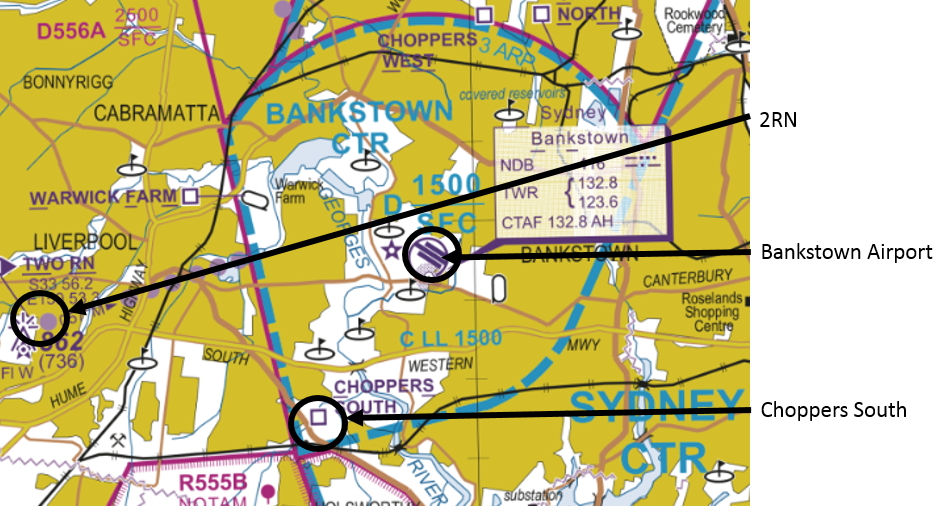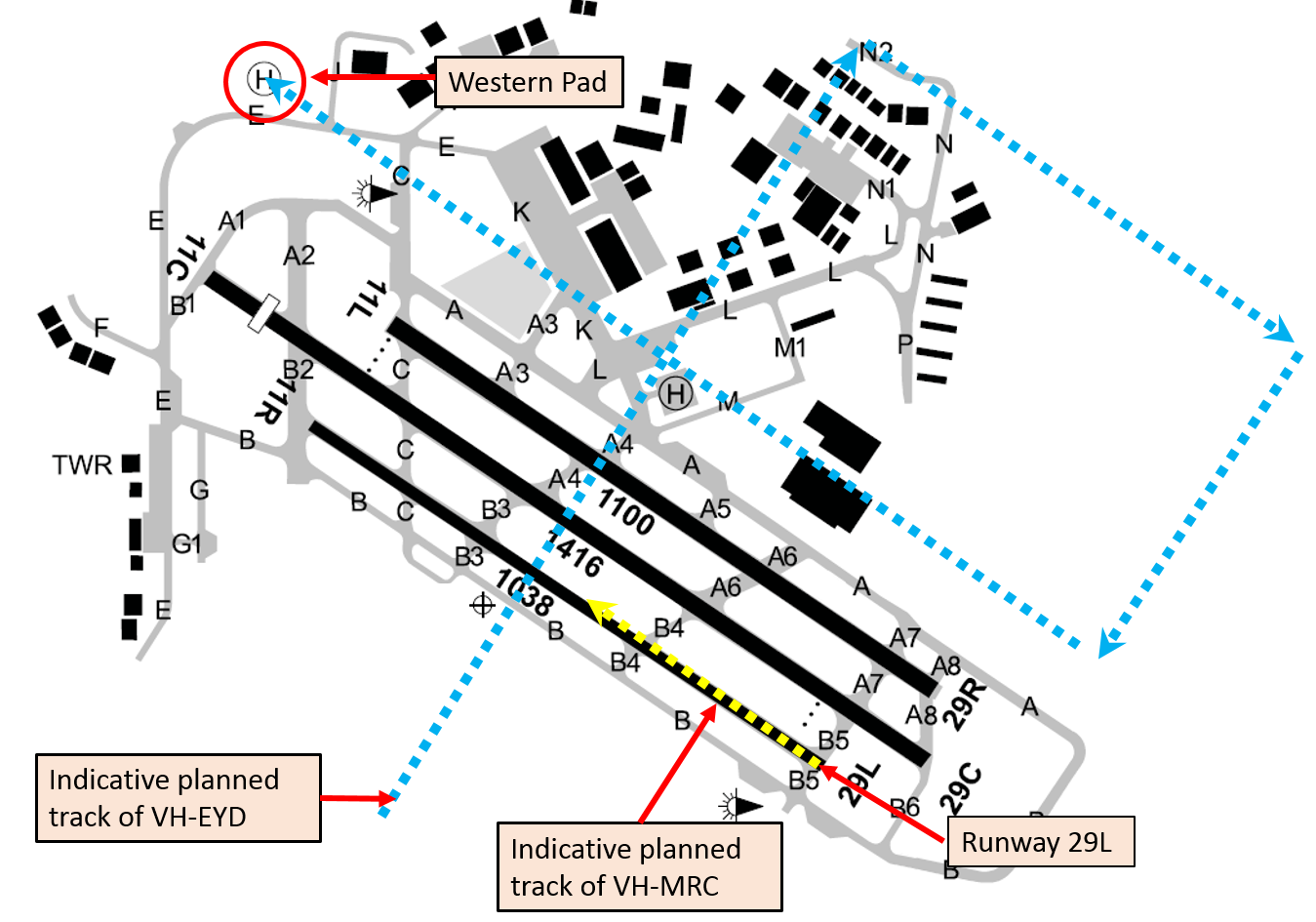What happened
On 25 August 2016, a Robinson R44 helicopter, registered VH-EYD (EYD), departed from Bankstown Airport on a training flight to Camden Airport, New South Wales. On board were a student pilot and a flight instructor. After completing exercises in the Camden area, the helicopter returned towards Bankstown.
According to air traffic control (ATC) audio data, at about 1607 Eastern Standard Time (EST), the instructor of EYD contacted the Bankstown aerodrome controller (ADC), advising that they were at inbound reporting point 2RN at 1,000 ft (Figure 1). The ADC instructed EYD to track via, and report at, ‘Choppers South’ reporting point at 500 ft. EYD then tracked via Choppers South at 500 ft, but the instructor omitted to advise ADC when they were overhead that point.
Figure 1: Extract of Sydney Visual Terminal Chart

Source: Airservices Australia – annotated by ATSB
At about 1610, the solo student pilot of a Cessna 152 aircraft, registered VH-MRC (MRC), who was conducting circuit training at Bankstown Airport, contacted the ADC and stated that MRC was on the downwind circuit leg, and requested clearance to depart the control zone on the upwind circuit leg. The ADC instructed the pilot of MRC to ‘go around from base, maintain 1,000 ft and depart on upwind’.
The pilot of MRC asked the ADC to repeat the instruction and then read back ‘MRC going around from base and depart at 1,000 ft’. The pilot of MRC then continued their approach, descending on the base leg and final approach to about 300 ft above the runway before commencing a go-around. At about 1613, passing about 500 ft on climb, the pilot of MRC advised the ADC that they were going around and departing at 1,000 ft upwind.
The ADC reported that they sighted MRC about mid-way along the runway, lower than the assigned altitude of 1,000 ft, and also sighted EYD about 200 m away at about the same altitude (Figure 2). The ADC immediately issued a safety alert[1] to the pilot of MRC advising of a helicopter (EYD) to their left crossing midfield at 500 ft. The ADC then issued a safety alert to EYD advising of the Cessna (MRC) in the go-around.
The instructor of EYD had already sighted MRC and commenced a right turn to increase separation. On receiving the safety alert, the pilot of EYD continued the right turn to pass behind MRC. EYD landed at the western helipad without further incident. MRC departed to the training area, before returning to land at Bankstown Airport, also without further incident.
Figure 2: Indicative aircraft tracks

Source: Airservices Australia – annotated by ATSB
Aerodrome control and radio frequencies
There were two Tower frequencies and two ADC positions at Bankstown, with ADC1 having responsibility for arrivals and departures on runways 29 right/11 left and 29/11 centre; ADC2 was responsible for the training circuit with runway 29 left/11 right.
The two Tower frequencies at Bankstown were combined at the time of the incident, and one controller occupied the ADC position. When combined, pilots of aircraft operating on either the circuit Tower frequency or the arrivals and departures Tower frequency would have been able to hear transmissions on the other frequency. Although the pilots of MRC and EYD had different radio frequencies selected, they were combined such that the transmissions made on both frequencies could be heard on either frequency.
Pilot comments
Pilot of MRC
The pilot of MRC was a student with 41 hours of aeronautical experience, six of which were solo. They provided the following comments:
- They had not departed from the circuit runway to the training area previously and were not sure how to do so or what to expect from ATC.
- Their understanding of a go-around was to descend as if on a normal approach to the runway, discontinue the approach on final at about 300 ft, apply full power and commence a climb, and diverge to the left of the runway.
- They misunderstood the ADC’s instruction, but were unsure why the controller had not noticed the aircraft descending on base and final before it commenced the go-around.
- They were not aware of the Choppers South arrival procedure until after the incident.
- If the instruction had been sequenced differently, with the direction to maintain 1,000 ft first, it would have made the ADC’s expectations clearer.
Controller comments
The ADC commented that if the pilot of MRC had maintained 1,000 ft there would not have been a separation issue. Having issued the instruction to maintain 1,000 ft, the ADC turned their focus to monitoring other aircraft and communicating with the pilots of other aircraft in the control zone.
The controllers have a liaison role with local flying schools, which involves visiting them and talking to the students, and they also invite students to the tower during quiet periods. This liaison fosters a safer working relationship between pilots and air traffic control.
Go-around
Aeronautical Information Package (AIP) En Route (ENR) 1.1 – 16.4 stated:
At Class D aerodromes with parallel runways where contra-rotating circuit operations are in progress, if ATC instructs, or a pilot initiates a go around, the pilot must:
commence climb to circuit altitude
position the aircraft on the active side and parallel to the nominated duty runway, while maintaining separation from other aircraft and
follow ATC instructions or re-enter the circuit from upwind.
The Manual of Air Traffic Services defined a go-around as a ‘procedure in which the pilot discontinues the approach immediately and rejoins for another circuit, or proceeds as directed by ATC’.
The ADC commented that when they issued the instruction to go around, they expected the pilot of MRC to terminate their approach and maintain 1,000 ft while continuing to fly the circuit geographically.
En Route Supplement Australia
The ERSA entry for Bankstown included the following under the heading Class D:
‘CAUTION: HELICOPTERS OVERFLY RUNWAYS MIDFIELD AT 500FT.’
Operator comments
The operator of MRC provided the following comments:
- Helicopter pilots inbound via Choppers South should be aware that crossing a training circuit runway is inherently risky as a go around can occur at any time and is obviously more likely to occur with low time student pilots who are more likely to not have their approach to land stabilised.
- It is also very likely that during their initial solo circuit training students will be more likely to be focussing on the preceding traffic they are following and will be less likely to see crossing helicopter traffic in their peripheral vision.
- Bankstown is a very busy training environment, which can have sudden increases in traffic volume. ATC needs to be aware of this as it is very difficult for student pilots to monitor traffic and radio calls and make broadcasts when conjoined frequencies are in operation, and there is a heavy traffic load.
- It is, and it always will be, company policy to safely fly the aeroplane first, navigate to the southern side of the runway and then communicate their intentions/actions.
Safety action
Whether or not the ATSB identifies safety issues in the course of an investigation, relevant organisations may proactively initiate safety action in order to reduce their safety risk. The ATSB has been advised of the following proactive safety action in response to this occurrence.
Operator of VH-MRC
As a result of this occurrence, the operator of MRC has advised the ATSB that they are taking the following safety actions:
Amended operations manual
The operator of MRC is proposing to amend their operations manual to read:
Unlicensed solo pilots are not permitted to request circuits on arrival or when inbound to Bankstown. Unlicensed solo pilots may only depart the training circuit after they have demonstrated proficiency in the procedure to an instructor and a note has been made in the training record to that effect
Safety message
The Civil Aviation Safety Authority booklet, Class D airspace, advises pilots that when operating in Class D airspace, they must sight and maintain separation from other aircraft. Pilots and ATC have a dual responsibility to maintain situational awareness of other traffic.
Aviation Short Investigations Bulletin - Issue 54
Purpose of safety investigationsThe objective of a safety investigation is to enhance transport safety. This is done through:
It is not a function of the ATSB to apportion blame or provide a means for determining liability. At the same time, an investigation report must include factual material of sufficient weight to support the analysis and findings. At all times the ATSB endeavours to balance the use of material that could imply adverse comment with the need to properly explain what happened, and why, in a fair and unbiased manner. The ATSB does not investigate for the purpose of taking administrative, regulatory or criminal action. TerminologyAn explanation of terminology used in ATSB investigation reports is available here. This includes terms such as occurrence, contributing factor, other factor that increased risk, and safety issue. Publishing informationReleased in accordance with section 25 of the Transport Safety Investigation Act 2003 Published by: Australian Transport Safety Bureau © Commonwealth of Australia 2016
Ownership of intellectual property rights in this publication Unless otherwise noted, copyright (and any other intellectual property rights, if any) in this report publication is owned by the Commonwealth of Australia. Creative Commons licence With the exception of the Coat of Arms, ATSB logo, and photos and graphics in which a third party holds copyright, this publication is licensed under a Creative Commons Attribution 3.0 Australia licence. Creative Commons Attribution 3.0 Australia Licence is a standard form licence agreement that allows you to copy, distribute, transmit and adapt this publication provided that you attribute the work. The ATSB’s preference is that you attribute this publication (and any material sourced from it) using the following wording: Source: Australian Transport Safety Bureau Copyright in material obtained from other agencies, private individuals or organisations, belongs to those agencies, individuals or organisations. Where you wish to use their material, you will need to contact them directly. |
__________


